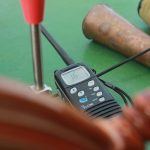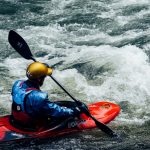Gators are a formidable species of animals that can attain lengths of up to 18 feet and weigh up to a thousand pounds. They possess an extensive array of food, such as fish, birds, turtles, and deer.
They possess formidable jaws and pointed fangs that enable them to seize their prey rapidly and productively. Their exquisite sense of smell and hearing allows them to identify prey from a considerable distance.
Alligators employ a strategy of lying in wait for their victim prior to launching an assault. This is the reason why alligators will go after kayakers who are not displaying signs or warnings when paddling down the river.
Are Alligators Dangerous?
Alligators are dangerous animals. They are present in various habitats, ranging from fresh and saline bodies of water. They are known for their speed, aggression, and ferocity.
Most of the time, alligators can be found in the water with only the top of their bodies visible above the surface. So how can they be dangerous? Alligators use their pointed fangs to catch victims before biting down with them. This makes it hard to get away from them when they have a hold of you with their teeth.
Alligators can indeed be dangerous because they have sharp teeth to grab prey before sinking their teeth into its body. However, alligators rarely attack humans because of the risk involved with getting close enough to them to make a successful attack on a human being.
Are Alligators Typically Aggressive In Nature?
Often, alligators are perceived to be hostile, although this is not necessarily the case. Many alligators are docile and even shy.
Humans typically view them as a danger due to their capability of being hazardous when they sense a danger or if their environment is intruded upon.
The way an alligator reacts can depend on the circumstances. If it feels threatened or if its habitat is invaded, it will respond defensively with aggression.
Can An Alligator Attack Anything Else Besides A Kayak?
Can alligators attack things other than a kayak? They can attack swimmers, dogs, and even humans.
How Can One Avoid Being Attacked By An Alligator While Kayaking?
Alligators are known for being both big and aggressive. It is essential to be cautious when kayaking in the vicinity of the water due to their superior strength relative to humans.
It is advisable to sidle up to an alligator and then back away from it, rather than going straight towards it. If there isn’t sufficient space, it is best to hastily paddle your kayak away from the alligator.
One can avoid being attacked by an alligator while kayaking by keeping the following in mind:
- The alligator’s mouth can open wide enough to take a person’s head off
- Alligators are known for their aggressiveness
- The alligator will bite when it feels threatened
- Alligators often attack from below, so if you’re in shallow water, stand up and paddle away
The safest approach to protect yourself from an alligator attack is to keep your distance from areas inhabited by them and refrain from paddling too close to the shoreline. When going out on a kayak, it is essential to put on a life jacket and be familiar with the proper use of your paddle.
Kayakers should be careful not to encounter any animals that may pose a threat. Dolphins and sharks are among the other animals which may attack you.
Why Do Alligators Attack Kayakers?
Canoeing is a well-liked pastime in the summer, however, it is not without its dangers. The most dangerous threat is the alligator attack.
It is widely believed that alligators are drawn to human odor, but this is incorrect. Alligators can spot kayaks from far away, making them simple targets to launch an attack against.
Injuries resulting from alligator attacks on kayaks usually lead to death, but there have been instances where individuals have managed to flee unscathed even after being dragged into the water for 30 seconds or longer.
How To Stay Safe If Kayaking Near Alligators
1. Keep Your Distance
It is advisable to maintain a distance of about 60 feet between yourself and an alligator. You should keep a safe distance that makes the alligator not perceive you as a potential threat.
Occasionally, an alligator could be encountered in this vicinity. When you encounter an alligator sunning itself on the sand or the embankment, it is best to move on from the area carefully, by maneuvering the kayak to be in parallel to the alligator.
Don’t paddle towards the alligator and don’t paddle furiously. It is advisable to stay composed and traverse the liquid in a hushed manner. Avoid pointing your kayak at the alligator.
If you come across an alligator, adjust your kayak’s direction so that you won’t head straight towards it. Make sure that your kayak’s front is not facing the alligator. You should still opt to pass from the side.
Nevertheless, if the alligator is tranquil, it is likely to slowly go back into the water in order to secure itself from the supposed danger. For precautionary reasons, it’s probably a wise decision not to kayak exactly on top of the alligator or the spot where it was last spotted.
It is advisable to provide a lot of space for alligators as they can swim up to 20 mph, which is faster than you can row.
2. Never Feed An Alligator
It is against the law to feed an alligator. Providing food to them can reduce their instinctive fear of people and teach them to connect humans with food. This poses a threat because it increases the possibility of alligators seeking people and kayaks as a source of sustenance.
Under no circumstances should you provide sustenance to any wild creatures when you are engaging in kayaking (or for any other reason). Doing so can damage their natural capacity to forage and may attract wild animals closer to residential neighborhoods where people reside.
No one desires a crocodile or a group of bears in their backyard.
It is also against the law to harass alligators.
3. Recognize An Alligator’s Body Language
Understanding the actions of an upset alligator can be critical if you propose to paddle in alligator habitats. It is similar to many other creatures and some humans, wherein there are clues that can be noticed to anticipate an alligator might become hostile or behave in self-protection.
Signs that can indicate an alligator is feeling angry or stressed include gaping of the mouth, hissing, and inflated body posture. One sign you might notice is hissing.
If you persist after hearing the hiss, you could observe other signs of displeasure, like a loud roar from the alligator. This is when the alligator produces a loud, deep roar in order to drive away opponents and call in potential partners.
When they do this, it will cause a visible rippling effect on the surface of the water from the movement of their backs.
They will lift their bodies out of the water. The alligators could also display agitation without bellowing by raising their bodies out of the water, producing a puffing motion.
If an alligator is drawing near you, it likely means it is not safe. If you are confronting an alligator, you should move away using your paddle in a backward motion. If an animal is quickly approaching your kayak, hit the side with your paddle or anything else you can find to make a loud noise and attempt to frighten it away.
4. Don’t Take Your Dog Kayaking
Dogs are approximately the same size as the animals that alligators hunt. Alligators eat fish, birds, and small mammals. Some will also consume pigs, sheep, cattle, deer, and on occasion, more diminutive gators.
Bigger alligators have been known to consume bears and even the endangered Florida panther. This implies that your canine can be a defenseless victim.
It is advisable that you keep your canine away from any body of water such as lakes, ponds, or rivers that could potentially harbor alligators. In Florida, any type of body of freshwater can be found.
You should never permit your dog to take a dip in any lake or river in Florida or any other state that is inhabited by alligators.
Navigating by kayak with your pooch can pose a greater danger, as the gator may be drawn to the aroma of your canine companion. It’s possible an alligator might come close to your kayak because it views it as a source of food.
5. Avoid Alligator Nests
Female alligators construct their nests on terrestrial ground at a distance of about ten feet away from any body of water. The nests look like mounds from the ground and are constructed using a selection of different plant materials.
When you’re canoeing, it may be too far away for you to detect if there is a mother alligator that is being protective in the vicinity because the mounds can’t be seen from the liquid. If you stray close to an alligator’s nesting grounds, it is likely you will be run off by the reptile. In the warmest months of the year, alligators build their nests, and their hatchlings emerge at the end of summer and beginning of autumn.
The most adept strategy while kayaking is to keep your distance from the shoreline as, if there is a concealed alligator nest, the gator could be nearby.
6. Be Extra Alert During Alligator Mating Season
Aggression levels among alligators are highest during their mating season. This time of year, typically starting in April and lasting through June, alligators tend to be more active.
This implies that they could be seen in places where they are not usually present, such as your garden or pool.
Stay vigilant while boating and be conscious that alligators may be present at the spot you are launching or docking your vessel. Alligators have the capability to move quickly on land at a maximum speed of 35 mph, although it is highly unlikely that they will maintain this rate for an extended period of time.
This is especially critical in kayak camping, as it is a possibility that a gator may be close to your basecamp or even beside your kayak when you wake up in the morning. It is especially probable for this to take place in camp sites located near the edge of a lake or river.
This could happen regardless of whether or not it is the mating season.
7. Don’t Jump Off Your Kayak To Swim
It is not advisable to bathe in bodies of freshwater in states where alligators are present. Individuals may go for a dip only in places specifically created for swimming, and yet, this is still not guarantee of safety, due to the fact that alligators can quickly migrate from one aquatic region to another.
Steer clear of swimming during the night hours all year long, as this is when alligators are most likely to be out hunting for food.
Stepping into a body of freshwater can be risky in areas that are inhabited by alligators, since the creature might not be visible to you as you move into the water to push your kayak away.
This comprises a major risk when taking a child with you to a body of water, as their smaller body can make them more susceptible to threat at the shoreline.
It can be a beneficial choice to enter your kayak from shore rather than from shallow water.
8. Don’t Block The Alligator’s Exit
Do not try to cut off an alligator that you are paddling directly towards to, or that is located nearby the shoreline. Allow the alligator enough space to be able to retreat into the water of its own accord.
If you get in the way of the alligator, it might become aggressive and cause a confrontation if it perceives you as a threat.
9. Carry A Sound Producing Device
In some areas, it is mandatory for kayakers and boaters to have on them a sound-emitting device. This is often expressed as a whistle. Using a whistle could be helpful, but if you’re looking for a more intense reaction, a blast from an air horn might do the trick when trying to ward off an angry alligator.
You can create sound by clapping your hands, yelling, or hitting the side of your kayak if you don’t possess an adequate tool to employ.
Finally, let’s ensure we are ready for all circumstances which might need us to escape a river with a crocodile.
If possible, be prepared for any eventuality in an emergency situation.
Evacuate the body of water right away. Ensure that you are in a safe spot away from any likelihood of an alligator getting close to you in the event that it isn’t conceivable. If the gator is already present, try to divert its attention by hurling rocks or sticks its way.




